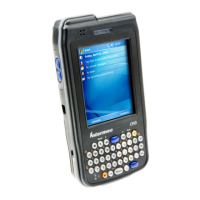Chapter 3 — Configuring the Computer
76 CN3 Series Mobile Computer User’s Manual
Configuring Security on the Wireless Network
Your wireless adapter (network interface card) connects to
wireless networks of two types: infrastructure networks and ad-
hoc networks.
• Infrastructure networks connect you to your corporate
network and the internet. Your computer establishes a wireless
connection to an access point, which links you to the rest of
the network.
• Ad-hoc networks are private networks shared between two or
more clients, even without an access point.
Each wireless network is assigned a name (or SSID) to allow
multiple networks to coexist in the same area without
infringement.
Intermec recommends using security measures with wireless
networks to prevent unauthorized access to your network and to
ensure the privacy of transmitted data. These elements are
required for secure networks:
• Authentication by both the network and the user
• Authentication is cryptographically protected
• Transmitted data
There are many schemes available to implement these features.
Use the following tables to understand the common terminology
for wireless network security.
Encryption Terminolog y
Acronym Description
AES Advanced Encryption Standard. A block cipher, a type of
symmetric key cipher that uses groups of bits of a fixed
length - called blocks. A symmetric key cipher is a cipher
using the same key for both encryption and decryption.
As implemented for wireless, this is also known as CCMP,
which implements AES as TKIP and WEP are
implementations of RC4.
CKIP Cisco Key Integrity Protocol. This protocol is Cisco’s
version of the TKIP protocol, compatible with Cisco
Aironet products.

